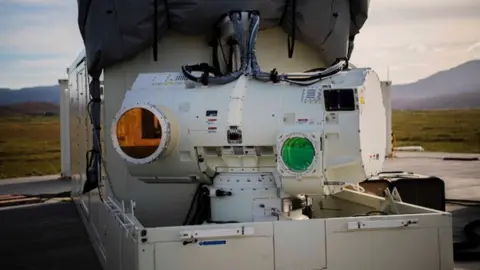A UK high-power laser weapon could be sent to Ukraine to take down Russian drones, the defence secretary says.
According to Grant Shapps, the weapon could have “huge ramifications” for the conflict in Europe.
The DragonFire weapon is expected to be rolled out by 2027, but Mr Shapps said he wanted to “speed up” production and make it available sooner.
It follows a successful trial of the laser, carried out against an aerial target for the first time in January.
The laser was originally expected to be operational by 2032, but new reforms intended to speed up government procurement of weapons mean that it will now be ready five years earlier.
Despite this, the defence secretary told reporters while on a visit to Porton Down military research centre near Salisbury that he wanted to speed this up even further.
“Let’s say that it didn’t have to be 100% perfect in order for Ukrainians perhaps to get their hands on it,” he said.
The Ministry of Defence (MoD) says the faster timetable comes in response to the “rapidly changing threat environment” faced by the UK.
“It’s designed to not wait until we have this at 99.9% perfection before it goes into the field, but get it to sort of 70% and then get it out there and then develop it from there,” Mr Shapps said.
“But 2027 is still the date as of this moment,” he continued.
 Ministry of Defence
Ministry of DefenceThe weapon is precise enough to hit a £1 coin from a kilometre away, according to the MoD. It is hoped that it will pave the way for a low-cost alternative to missiles, to shoot down targets such as drones.
January’s successful test of the weapon was carried out at the MoD’s Hebrides Range in Scotland and was hailed as a “major step” in bringing laser-directed energy weapons (LDEWs) into service.
The greatest advantage of lasers is cost and, in theory, an “unlimited magazine” of ammunition – as long as there is a reliable source of power. But the big drawback is that they can only fire at targets in the line of sight, unlike most missiles.
The US has been testing directed-energy weapons for decades. They have been fitted on to several warships for trials and evaluation.
The UK’s ambition to do the same by 2027 might be possible, but lasers have not been tried and tested in battle. US warships are still shooting down Houthi drones in the Red Sea with conventional missiles.
Any suggestion that UK lasers could be sent to Ukraine to take out Russian drones is optimistic.
Ukraine’s demands are more urgent. It requires mobile air defence systems which have been proven in battle. With its electrical grid constantly being targeted by Russia, lasers which require a source of power, are unlikely to be the solution to Ukraine’s urgent needs.
LDEWs use an intense light beam to cut through their target and can strike at the speed of light. As a line-of-sight weapon, it can attack any visible target that is close enough, although the range of the DragonFire system is classified.
Missiles can be far more expensive than the drones they destroy, with some costing millions of pounds compared with a few thousand.


